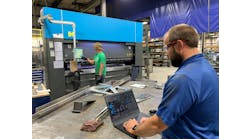|
T |
he three organizations that use Device Description (DD) technology as the basis for the interoperability of their devicesHART Foundation, Fieldbus Foundation and Profibus Nutzerorganisation e.V. (PA component)recently announced the release of EDDL (Elementary Device Description Language) Phase 1 as a means to provide users with a number of enhancements to the ability of their devices to represent more data intense information such as tables, graphs and images.
This is only one of the battlegrounds at present, since the bar on the fieldbus wars of the past has been raised to the next layer or two of the enterprise. The war is now taking place not only at the control level, layer 2, with the various flavors of Ethernet, it is also happening at the layer 2/layer 3 interface. This is where information available from data rich environments is being integrated into the asset management solutions being offered not only by each of the automation system suppliers but also the big guns such as SAP.
|
RELATED STORY Are fieldbus wars heating up again? CONTROL Editor in Chief Walt Boyes provides analysis and commentary. |
Despite the fact that Phase 1 is a significant improvement over the present text-only representation supported by these protocols, EDDL Phase 1 is a beginning on which to build better platforms in the future. The analogy is that DDL is presently in the DOS days, EDDL Phase 1 is like Windows 3.2 and EDDL Phase 2 will be the Windows NT release. In the interim, end users will continue to use what they have and be innovative in how it is applied, including the use of work-arounds if necessary. Its competition is FDT/DTM (Field Device Tool/Device Type Manager) from Europe. When asked for his thoughts on EDDL/FDT, Jim Sprague, a controls engineer with a major Middle East oil and gas producer/refiner responded, We are counting on EDDL and FDT/DTM to fully deliver on Foundation Fieldbus (FF) promise of giving us âbest in class instrument choice. Sprague continued, Our company is moving ahead strongly with FF use, but we still have to be careful about our instrument selection to make sure Host âPlug-Ins or âSnap-Ons are available to give us full access to instrument maintenance features and diagnostics. We look forward to the time when we can choose best in class FF instruments and just know we will get everything at the host.The EDDL-FDT/DTM conundrum is a small part of the battle to integrate the abundance of information available from a modern integrated digital control system and effectively use it to increase the bottom line. Many end users are taking advantage of the additional information to operate their facilities in a more reliable way using asset management or maintenance system solutions but, as indicated above, are experiencing difficulties getting all the parts to play nicely together.Another end user in Northern Europe responded to my inquiry on the impact of EDDL by saying The (host) manufacturer that supports full functionality of non-host devices will have an advantage in the market.This confirms that end users are not so much interested in the technology used to provide them the information they require, but rather the content of the information itself and hence the use of FDT/DTM to get that information if it is not available from fieldbus directly. FDT/DTM uses DD technology as the basis on which it enables the device manufacturer to represent the information in their device the way they wish, rather than how the host or maintenance system supplier thinks it should be done. Obviously, if the maintenance system supplier manufactures an end device, it is going to integrate it more tightly into its system than someone elses product and hence the request or need for FDT/DTM to fill a void. Interestingly, some speculate that the EDDL enhancements were driven not so much by end users but the competition from FDT/DTM.
|
WHITE PAPER EDDL: The Technology Behind Interoperability EDDL now is being enhanced to extend the concept of interoperability to the HMI and diagnostic data. |
As all CONTROL magazines readers likely know, Ethernet describes the Physical Layer of the OSI seven-layer model and, since most industrial protocols also use Internet Protocol (IP) and User Datagram Protocol (UDP), the Data Link Layer is also fairly common. The biggest differentiator is the User Layer, which of course is not part of the OSI model.The question here, especially in the non-wet industries, is not if Ethernet will arrive, but when and how low can it go? Brian Oulton of Rockwell Automation indicates that traditional RS-232 communications are all now migrating to some form of Ethernet, especially since a number of chip vendors are offering dual stack silicon with, for example, Modbus/TCP and Ethernet on the same chip. Oulton also points out that manufacturers are still using proprietary protocols on Ethernet, which is not the best way to go since there is broader acceptance of solutions if an open solution is selected and the emphasis is placed on differentiating features.This is consistent with what end users are saying as well. They would rather be able to pick the features they need from the manufacturer they need instead of spending their time mapping protocols and building gateways.With the merger of companies both on the supplier and end user side continuing, it is becoming necessary for engineers to support multiple control environments with different hosts. It would be much simpler and efficient if it was possible to integrate the existing equipment with a new control solution by means of a common network, likely some form of Ethernet, through a single gateway supplied by the host manufacturer. This is done today when a manufacturer upgrades its control system to a new platform. If standards for integration and upgrade of multiple manufacturer devices existed, the same could be done across manufacturers as well. A definite win for all involved since the host manufacturer will still get the revenue to support the legacy system and the end user will be able to continue using his or her investment in hardware and software as long as possible.History has shown that Emerson Process Managements release of DD technology into the public domain has been a boon for the development and integration at Layer 0 and 1 of the enterprise, along with the associated benefits identified above; the same could be expected at each of the other layers as well. Sure, users could mix and match components from many suppliers in a single system. It is unlikely they will, because they will then have to carry parts for multiple manufacturers, learn about each manufacturers equipment, and manage all the interfaces themselves when they could simply expect a single source to provide a complete solution instead. What may happen is that users will continue picking a single supplier to provide a function, such as safety system, basic controller, maintenance solution, etc., and know that they will integrate into a complete solution.Fieldbus SafetySafety in a Spec
The final topic that is garnering the attention of the fieldbus specification developers is that of applying safety in fieldbus systems. As mentioned above, ISA is doing its part to make this possible while both Profibus and Fieldbus Foundation are spending considerable effort on their standards as well. Unfortunately, that is all they are doing at present and it seems that it could be at least another year before we see product available. It is also unfortunate that it does not appear that any of the standards under development will address all the requirements being identified by the ISA-84 subcommittee, at least on the first release. What they are doing however, is using what is called a black channel to take advantage of the existing Profibus PA or Fieldbus H1 standards to handle the communications portion of the network and then adding the safety functionality and checks on top of this infrastructure.An end user in Europe is looking forward to the availability of fieldbus safety because, Not only do we feel it will help increase the reliability of the existing standards, it will also allow for the use of diagnostic capabilities on the application level. As result the loop diagnostic coverage factor will increase and manual testing to prove functionality of the safety system will be reduced. On the control level the diagnostics will reduce the demand rate on a safety loop so, compared to todays situation, scenarios will be classified to a lower SIL level.With respect to the infrastructure there are two philosophies: (1) Control and safety functions should not be integrated in the chemical industry, and (2) Control and safety functions are integrated on a segment.Its likely that in the next few years, fieldbus safety will be implemented and if the technology is proven and end users are familiar with the technology, the functionality of mixing control and safety functions on the segment will be implemented. In this situation the use of a separate PLC system will be eliminated.The Final ChallengeThe Enemy Within
The challenge with all networking technologies that will not be solved by the protocols, including safety buses, is that the equipment must first be installed correctly. From my personal experience, which has been confirmed by many others, installation problems are the cause of 90% of network problems. Getting the physical connections and terminations done properly is critical to the successful implementation of a project.Bill Gates recently indicated that people are often too optimistic when forecasting two years into the future, and too pessimistic when looking 10 years ahead, so only time will tell if the fieldbus wars will be over at the end of the decade or simply moved on to another layer of the enterprise. It is my hope as well as that of many others that the wars will be over long before then. Ian Verhappen is Director at ICE-Pros, Inc. an independent instrument and control engineering consulting firm specializing in fieldbus, oil sands automation, and process analyzer sample systems. Ian can be reached at [email protected]or through his web sitewww.ICE-Pros.com.

Leaders relevant to this article:



